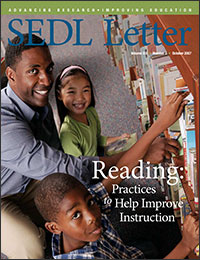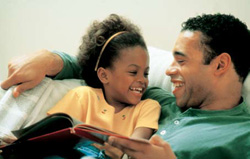Opening Books to Fathers and Children Strengthening Children's Literacy
When most people think about parent-child reading activities, they likely picture a mother quietly reading to their children. Very few people would envision a reading event for just fathers and children. Even fewer would envision a reading event where these same fathers and children are acting like donkeys, elephants, and gorillas. That is exactly what happens, however, at a Dad and Kid Reading Night sponsored by Strong Fathers-Strong Families. Strong Fathers-Strong Families is a training, technical assistance, and facilitation organization focused on connecting fathers to their children, to their local school or Head Start program, and to their children’s learning outcomes.
Dad and Kid Reading Night encourages and teaches fathers to read to their children. The program’s effectiveness is derived from using the inherent strengths of fathers. Instead of teaching men to read in a softer, more feminine way, these events model a more lively, no-holds-barred approach to reading and interacting with their children. In this activity men and children are settled into the floor together and a facilitator reads to them in a typically masculine way with lots of excitement, crazy voices, and noises. The books are carefully chosen both to reflect the father-child dynamic and to facilitate lively activity between the child and the father. To make this event effective, a Dad and Kid Reading Night must be interactive, relational, and focused on child outcomes.
The Strength of Interactivity
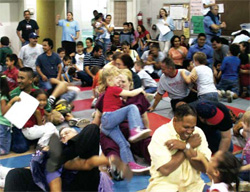
Dads, kids, and even a few moms have a great time at Dad and Kid Reading Night.
The interactivity is an integral part of the program because men tend to be more easily engaged through activity and fathers tend to engage kids in more rough-and-tumble play. Researchers say that this rough play can have a powerful positive impact on children, fostering curiosity and teaching them to regulate emotion and enjoy surprises (Pruett, 2000). By using a strength-based approach with fathers, practitioners can encourage and teach them to spend more time in reading their way to their children. Just as boys and girls are different and men and women are different, we must recognize that mothers and fathers are different (Pruett, 2000; Lamb, 1997; Park, 1995). Fathers and mothers parent differently Strengthening Children’s Literacy Opening Books to Fathers and Children and interact with their children differently. That difference in parenting styles is also present in how fathers talk to and read to their children. A recent University of North Carolina study found a link between fathers who used varied vocabulary with their 2-year-olds and the children’s more advanced speech at age 3, even though the fathers’ spoke less often to the children than did the mothers. Mothers’ vocabulary didn’t have a significant impact (Pancsofar & Vernon-Feagans, in press). A study of low-income Early Head Start fathers (Tamis- LeMonda, Shannon, & Cabrera, 2004) found a link between fathers’ stimulating play with their 2-yearolds and better language and cognitive skills in the children a year later, even when controlling for mothers’ behavior. As early as the 1960s, psychologist Ellen Bing found (to her surprise) that children who had fathers who read to them regularly were more likely to do much better in many important cognitive skill categories than children who did not (Bing, 1963). One of the strongest benefits was a substantial increase in a daughter’s verbal skills. These acknowledged paternal strengths are used to engage fathers with their children and to help fathers understand their own powers as readers.
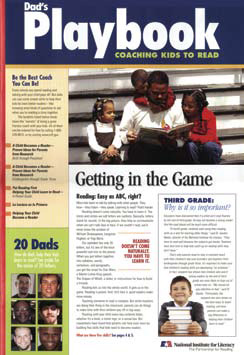 | Dad’s Playbook: |
Now Available Free of ChargeDad’s Playbook may be ordered free of charge by e-mailing edpubs@inet.ed.gov or calling toll-free 800-228-8813. You may also download a copy at the institute’s Web site, www.nifl.gov/partnershipforreading publications/pdf/Dads_Playbook.pdf. |
The Strength of Relationship
The premise of a Dad and Kid Reading Night is to bring fathers in to experience this power of masculine reading and how it impacts the education of their children. This experience is facilitated by reading to both fathers and children and having them interact with the books that are being read to them. Some of the books are focused on the father-child relationship, and some of the books are focused on fun activities between fathers and children. Even though the fathers are not reading to their children, they are learning a lot about the power they possess as fathers and masculine readers. Besides taking part in the activities, fathers are also observing other fathers playfully interacting with their children and the reaction of their children to both the books and the interplay between them. Therein lies the power of the event. It is not the actual reading of books, it is not the modeling of a masculine style of reading, and it is not the information that is being presented to the fathers during the workshop. 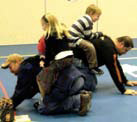 Even though those aspects of the program are valuable, it is the interaction with their children during the activity that sells fathers on their personal power as masculine readers. The relational aspects of the event are the primary draw to both children and fathers. The event is billed as a “dad and kid” event. Instead of developing catchy titles like “Daddy Read to Me” or “Book Look,” the creators of the program used a simple title that helps participants understand that they are invited together to come and interact. By using a title that puts the father and child on an even footing, you can communicate that they both have an important role to play in the process.
Even though those aspects of the program are valuable, it is the interaction with their children during the activity that sells fathers on their personal power as masculine readers. The relational aspects of the event are the primary draw to both children and fathers. The event is billed as a “dad and kid” event. Instead of developing catchy titles like “Daddy Read to Me” or “Book Look,” the creators of the program used a simple title that helps participants understand that they are invited together to come and interact. By using a title that puts the father and child on an even footing, you can communicate that they both have an important role to play in the process. 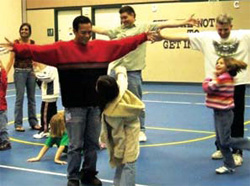 The relational hook is used as fathers and children are drawn closer and closer together through a series of books that start out on the emotionally “safe” side and then move into more tactile and intimate interactions like wrestling and hugging. Once the hugging starts, it is usually hard to stop, even among older elementary students. Most fathers are happy to oblige. Simply telling a man that he possesses a certain strength that can help his child can be helpful. When you show him his strength through the behavior of his child, it is more than helpful—it is powerful. The power of this relationship can be easily seen during such an event, and the fathers’ evaluations following the event indicate that they saw it as well.
The relational hook is used as fathers and children are drawn closer and closer together through a series of books that start out on the emotionally “safe” side and then move into more tactile and intimate interactions like wrestling and hugging. Once the hugging starts, it is usually hard to stop, even among older elementary students. Most fathers are happy to oblige. Simply telling a man that he possesses a certain strength that can help his child can be helpful. When you show him his strength through the behavior of his child, it is more than helpful—it is powerful. The power of this relationship can be easily seen during such an event, and the fathers’ evaluations following the event indicate that they saw it as well.
| The most useful books for this type of activity are based on a positive father-child relationship, a set of positive interactions, or both. Here is a list of the books that Strong Fathers-Strong Families has made a standard for this program every time it is presented to dads and kids in schools and Head Start programs.
Head to Toeby Eric Carle This book is used as a warm-up to get everyone moving and allows the fathers to slowly become a part of the activity. It is also the activity that promotes participants to act like giraffes, buffaloes, donkeys, monkeys, and gorillas. Guess How Much I Love Youby Sam McBratney and Anita Jeram This book illustrates a loving relationship between father and son nutbrown hares. When used at reading night, it allows for fathers and children to literally show how much they love each other with outstretched arms and legs. Going on a Bear Huntby Michael Rosen This well-known story and song is presented in a beautifully illustrated book encourages fun interaction for dads and kids with lots of predictability and repeating text. Octopus Hugby Laurence Pringle This book provides activities for dads and kids to do at home. It has a great story about a dad who stays with the kids while the mom is gone to dinner. Watching a group of fathers all give their kids an “octopus hug” (with eight arms) makes the all the effort you put into the event well worth it.
| |
Other great books for dads and kids: | |
How to Be a Happy Hippoby Jonathan Shipton Night Drivingby John Coy and Peter McCarty Daddies Are for Catching Firefliesby Harriet Ziefert Daddy Is a Doodlebugby Bruce Degen Daddy Makes the Best Spaghettiby Anna Grossnickle Hines The Daddy Mountainby Jules Feiffer Dad’s Dinosaur Dayby Diane Dawson Heard Kevin and His Dadby Irene Smalls Lots of Dadsby Shelley Rotner and Sheila M. Kelly My Dadby Debbie Bailey | My Daddy and I . . .by Eloise Greenfield Night Shift Daddyby Eileen Spinelli The Night Workerby Kate Banks On a Wintry Morningby Dori Chaconas Pete’s a Pizzaby William Steig Rainy Dayby Emma Haughton A Special Kind of Loveby Stephen Michael King Tom and Pippo Read a Storyby Helen Oxenbury The Very Best Daddy of Allby Marion Dane Bauer Vroomaloom Zoomby John Coy What Dads Can’t Doby Douglas Wood |
The Strength of Outcomes
Even though these events are fun, they must be planned and developed in such a way that they improve children’s learning outcomes. Fun and games are ingredients of these events but not the main goal. There are all kinds of parent-child programs that have fun activities, but this event is designed to maximize the interaction, both verbal and tactile, between father and child. By focusing on the child outcomes, not only can you reach the goals of your campus or program, but you can also begin to form a partnership with the fathers and families to improve their children’s outcomes. By giving fathers a job to do within their strengths and focusing them on the positive outcomes for their children, they are more than eager to join the team. Even if a father does not read well or cannot read at all, this activity can demonstrate to him that there is power in words shared through stories, specifically stories shared by a father. Although the event encourages reading to the children, fathers are also told that they can have a big impact on their children’s literacy just through story-telling and direct verbal and physical interaction with their children. Many men are embarrassed or intimidated by their lack of competency in reading and/or reading out loud. However, when given options (that are still based on their strengths and in spite of their weaknesses) to benefit their children, they are more likely to rise to the occasion. In order to affect outcomes, the information that is provided to fathers is simple and direct. A tip sheet for fathers on developmentally appropriate reading skills provided by the National Institute for Literacy Institute (2006) is used to give fathers basic tips and hints to help them in their future reading activities. Fathers and children are encouraged to seek out some of the same books that were shared during the event to continue this interaction through some of the activities that they learned.
The Strength of Differences
If most educators were to see a Dad and Kid Reading Night in person, they might assume that it is fun—and at times even silly—but that it does not have any impact on student outcomes. However, by speaking to the strengths of the fathers, providing the fathers an opportunity to experience these strengths in a safe environment, and allowing the fathers to see their children’s reaction to the activities, this event serves as a solid teaching tool.
References and Suggested Readings
- Bing, E. (1963). Effect of child-rearing practices on development of differential cognitive abilities. Child Development, 34(3): 631-648.
- Lamb, M. E. (1997). The role of the father in child development (3rd ed.). New York: John Wiley & Sons, Inc.
- National Institute for Literacy. (2006). Dad’s playbook: Coaching kids to read. Washington, DC: Author.
- Pancsofar, N., & Vernon-Feagans, L. (in press). Mother and father language input to young children: Contributions to later language development. Journal of Applied Developmental Psychology.
- Park, R. D. (1995). Fathers and families. In B. H. Bornstein (Ed.), Handbook of parenting (Vol. 3). Mahwah, NJ: Lawrence Erlbaum Associates.
- Pruett, K. D. (2000). Fatherneed: Why father care is as essential as mother care for your child. New York: The Free Press.
- Tamis-LeMonda, C. S., Shannon, J. D., & Cabrera, N. (2004). Mothers and fathers at play with their two-to three-year olds. Child Development, 75(6), 1806–1820.
Michael J. Hall, MEd, is the executive director of Strong Fathers, Strong Families. He is a former teacher and principal and was director of the Dallas-Fort Worth field office for the Center for Successful Fathering, Inc. As director of Strong Fathers, Strong Families, Mike conducts workshops around the country and makes presentations at the conferences of such organizations as the National Head Start Association, the Texas Association of School Boards’ Parent Learning Network, the Dakota Father Initiative, and the California Head Start Association.
Next Article: Response to Intervention (RtI): A Systematic Approach to Reading and School Improvement
